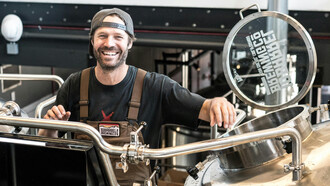Argentina has been one of the top wine-producing countries on the planet. It is especially known for the emblematic varietal, Malbec. 17 April is celebrated as International Day of Malbec. In the last two decades, Argentinian Malbec wines are minting a high number of sales. Today Malbec is the most cultivated variety in Argentina and stands for more than fifty per cent of bottled exported wine in volume which covers a whopping three-fourths of global wine production. Malbec traces its origins to Cahors and Bordeaux in South West France. However, as the thin-skinned grape variety tinged with a purple ink hue calls a warmer climate, Malbec travelled to the sunny vineyards of Argentina where it is quoted to have “reached its peak” in expression and ingenuity.
Apart from France; Australia, New Zealand, Chile, the USA and South Africa are also successful wine-growing countries competing for a substantial share in the Malbec market. But Argentine Malbec is unparalleled the superior one among all the producers due to its unique terroir strongly marked by thermal excursion, barren soil and altitude giving it a fruit-forward and velvety soft texture that only Malbecs from Argentina enjoy.
“Malbec in parts of Europe is harsh and not well-balanced. It’s Argentina where Malbec blossomed to become a great wine, elegant with good minerality, fine fragrance and a large spectrum of flavours ” says, Italian Food and Wine Expert Mr Luca Bernardini.
Argentina’s vineyards are located on high valleys far from the ocean and close to the Andean mountains in a majestic landscape of unparalleled natural beauty which along with the warmth of its people, make it also a wonderful place to enjoy a unique experience of open tourism i.e., escape from the drudgery of daily lives while losing ourselves to a relaxing atmosphere which gave birth to some of the best wines in the world. Due to the vast expanse of its territory, Argentina presents plenty of diversity in terroirs. The stunning vineyards are located at altitudes between 980 and 9840 ft above sea level. Mythic Estate, Alta Vista’s Mendoza vineyards and Bodega La Rosa’s Michel Torino wines are three wineries whose wines are predominantly present in the Indian market coming from two exemplar regions: Mendoza and Salta. Owing to subtle differences in humidity, insolation, temperatures and soil type, many profiles of Malbec are recognized for the peculiarity of taste and heterogenous composition that can be traced. In other words, there are other flavours, with increasingly rare and rich combinations that are reaching the stores and forcing us to redefine our descriptive palette.
The finest quality of Argentine Malbec flourishes in the land spread of 25,000 hectares within the Mendoza region. Pedro Pascal Segura, governor of Mendoza in the nineteenth century is an important father figure in the intertwining of Malbec and Argentina. Not only did he singlehandedly save Malbec from extinction, but opened an education centre which paved way for a bright future in wine research in the region. The governor was introduced to the charm of Malbec by renowned ampelographer Michel Aime Pouget and the rest is history. Expert sommeliers rate Malbec as a viable appetizer, that blends well with a wide range of dishes while remaining a perfect catalyst for long-lasting conversations. The traditional Argentine Asado always goes hand in hand with Malbecs.
The tangy red wines are also famously a best friend of meat dishes. The meat can be in any form grilled, baked or stewed. The resulting flavour is nothing less than ultimate. No wonder the traditional Argentine Asado always goes hand in hand with several pairings of Malbec wine. As for the vegetarian assortments, Malbec has a soft corner for mushrooms, spices and goat cheese, gouda or gorgonzola.
“The increasing popularity of Malbec in South East Asia has to do with its wonderful taste profile that matches perfectly with Indian cuisine, especially with hearty meals of chicken, mutton, pork and it also pairs well with cheese. Because Malbec is a full-bodied wine with medium acidity and medium tannins it goes well with strong dishes such as a garam masala lamb dish. Malbec also has two to four times the amount of anti-inflammatory, health-boosting antioxidants than other popular red wines like Cabernet Sauvignon and Merlot. The drink is most preferred by the young urban consumers in major cities of India as well as high net individuals that are already familiar with Malbec because of their travels”) observes H.E. Guillermo Devoto, a diplomat who is currently serving as Consul General and Trade Commissioner of Argentina to Mumbai.
Malbec wines are demarcated by an ethereal touch. A sip of classic Malbec is composed of fresh tannin pulp lingering on the fruity lusciousness of plum, raisins and berries coupled with a mild acidic shot. A delightful addition of tobacco, oak, and dark chocolate elevates the natural palate with a satisfying finish. On a side note, violet flowers can add on as a viable aromatic blend. A cooler room temperature defines a superior experience of Malbec while a wine glass that provides for an energetic swirling unfurls the best taste. Because this glossy, dark-coloured wine is punched with a robust aroma, excessive barrel maturation is not necessary. Expensive bottles of Malbec are accordingly a magical addition to the cellar as the decanted liquid evolves in the bottle over a relatively shorter period of time. Most of the Malbec bottles that you can find on the market are very much young, aged for not more than six months.
The centuries-old Argentine Malbec is confidently marching into the future with a passport to emerging markets beyond Europe and the Americas. The young generation continues to embrace its ever-expanding universe of flavours as their go-to muse through parties and festivals. Quite obviously, while the world gets older, Malbec is reversing the timeline, getting more youthful with age.















